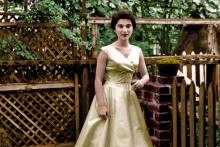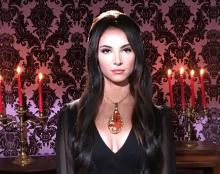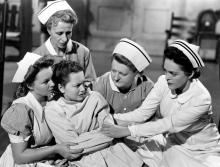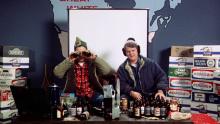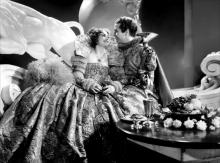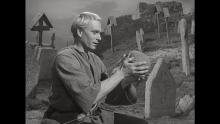By Jim Healy, Director of Programming, UW Cinematheque & Wisconsin Film Festival
Between January 1 and December 31 in 2016, I managed to view 634 feature films that I had never seen before. My list of favorites contains recent releases and other movies from throughout cinema history. I encourage you to see as many as you can.
My very favorites, in alphabetical order:
ALLIED (2016, Robert Zemeckis)
THE BFG (2016, Steven Spielberg)
BLONDE CRAZY (1932, Roy del Ruth)
DON’T BREATHE (2016, Fede Alvarez)
THE EDGE OF SEVENTEEN (2016, Kelly Fremon Craig)
ELLE (2016, Paul Verhoeven)
FINDING DORY (2016, Andrew Stanton)
LA HORSE (1970, Pierre Granier-Deferre)
HUNT FOR THE WILDERPEOPLE (2016, Taika Waititi)
KUBO AND THE TWO STRINGS (2016, Travis Knight)
LA LA LAND (2016, Damien Chazelle)
MOANA (2016, John Musker, Ron Clements)
NORTH WEST FRONTIER (FLAME OVER INDIA, 1959, J. Lee Thompson)
PATTES BLANCHE (1949, Jean Gremillon)
RAWHIDE (1951, Henry Hathaway)
SAMMY GOING SOUTH (1963, Alexander Mackendrick)
SING (2016, Garth Jennings)
THE WELL (1951, Leo Popkin & Russell Rouse)
TO EACH HIS OWN (1946, Mitchell Leisen)
ZOOTOPIA (2016, Rich Moore, Byron Howard)
I also got a lot of pleasure out of the following movies, in alphabetical order:
10 CLOVERFIELD LANE (2016, Dan Trachtenberg)
20,000 YEARS IN SING SING (1932, Michael Curtiz)
A TIME TO LOVE AND A TIME TO DIE (1958, Douglas Sirk)
AFRAID TO TALK (1932, Edward L. Cahn)
ALICE IN THE CITIES (1974, Wim Wenders)
ARRIVAL (2016, Denis Villenueve)
AUTHOR: THE J.T. LEROY STORY (2016, Jeff Feuerzeig)
L'AVENIR/THINGS TO COME (2016, Mia Hansen-Love)
BACHELOR’S AFFAIRS (1932, Alfred Werker)
BACK STREET (1932, John M. Stahl)
BACKGROUND TO DANGER (1943, Raoul Walsh)
BIG CITY BLUES (1931, Mervyn LeRoy)
THE BIG BROADCAST (1932, Frank Tuttle)
THE BIG RACKET (1976, Enzo G. Castellari)
THE BIG SHAKEDOWN (1934, John Francis Dillon)
BILLY LYNN’S LONG HALFTIME WALK (2016, Ang Lee)
BITE THE BULLET (1975, Richard Brooks)
BUREAU OF MISSING PERSONS (1933, Roy Del Ruth)
CAN HEIRONYMOUS MERKIN EVER FORGET MERCY HUMPPE AND FIND TRUE HAPPINESS (1969, Anthony Newley)
IL CAPPOTTO (1952, Alberto Lattuada)
CAPTAIN BLOOD (1935, Michael Curtiz)
CAROL (2015, Todd Haynes)
CENTRAL AIRPORT (1933, William A. Wellman)
CHANDU THE MAGICIAN (1932, Marcel Varnel & Wm. Cameron Menzies)
THE CHASE (1946, Arthur Ripley)
THE CINEMA TRAVELERS (2016, Shirley Abraham, Amit Madheshiya)
COLOSSAL (2016, Nacho Vigalondo)
COPS AND ROBBERS (1973, Aram Avakian)
DANTE’S INFERNO (1935, Harry Lachman)
DE PALMA (2015, Noah Baumbach & Jake Paltrow)
DEATH IN SARAJEVO (2016, Danis Tanovic)
DEVIL AND THE DEEP (1932, Marion Gering)
DIARY OF A MADMAN (1963, Reginald Le Borg)
DIE NIBELUNGEN: KRIEMHILD’S REVENGE (1924, Fritz Lang)
DIE NIBELUNGEN: SIEGFRIED (1924, Fritz Lang)
DOGS (2016, Bogdan Mirica)
DOUBLE JEOPARDY (1999, Bruce Beresford)
DRAGON LORD (1982, Jackie Chan)
DRUM (1976, Steve Carver)
THE EAGLE AND THE HAWK (1933, Stuart Walker)
THE FIRST LEGION (1951, Douglas Sirk)
EL NORTE (1983, Gregory Nava)
EUROPE ’51 (1952, Roberto Rossellini)
EVER IN MY HEART (1933, Archie Mayo)
EX-LADY (1933, Robert Florey)
FALBALAS (1945, Jacques Becker)
FENCES (2016, Denzel Washington)
LES FILS DE JOSEPH (2016, Eugene Green)
FIRST GIRL I LOVED (2016, Kerem Sanga)
FLORENCE FOSTER JENKINS (2016, Stephen Frears)
FLYING DEUCES (1939, A. Edward Sutherland)
FRONT PAGE WOMAN (1935, Michael Curtiz)
THE GLASS WEB (1954, Jack Arnold)
GOLDSTONE (2016, Ivan Sen)
HACKSAW RIDGE (2016, Mel Gibson)
HAIL, CAESAR! (2016, Joel & Ethan Coen)
HELL OR HIGH WATER (2016, David Mackenzie)
A HEN IN THE WIND (1948, Yasujiro Ozu)
HER MAN (1930, Tay Garnett)
HER SISTER’S SECRET (1946, Edgar G. Ulmer)
HI, NELLIE! (1934, Mervyn LeRoy)
HOTEL DU NORD (1938, Marcel Carné)
A HOUSE DIVIDED (1931, William Wyler)
I AM THE PRETTY THING THAT LIVES IN THE HOUSE (2016, Osgood Perkins)
I SELL ANYTHING (1934, Robert Florey)
I, DANIEL BLAKE (2016, Ken Loach)
ILLEGITIM (2016, Adrian Sitaru)
THE INTERN (2015, Nancy Meyers)
JULIETA (2016, Pedro Almodóvar)
JUSTIN TIMBERLAKE AND THE TENNESSEE KIDS (2016, Jonathan Demme)
THE KISS BEFORE THE MIRROR (1933, James Whale)
KUNG FU PANDA 3 (2016, Alessandro Carloni, Jennifer Yuh)
THE LAST CHANCE (1945, Leopoldo Lindtberg)
LAUGHTER IN HELL (1933, Edward L. Cahn)
LILIES OF THE FIELD (1963, Ralph Nelson)
LITTLE MEN (2016, Ira Sachs)
LIVE LIKE A COP, DIE LIKE A MAN (1976, Ruggero Deodato)
LA MAIN AU DIABLE (1943, Maurice Tourneur)
THE LOVE WITCH (2016, Anna Biller)
THE MAGNIFICENT SEVEN (2016, Antoine Fuqua)
MALONE (1987, Harley Cokliss)
MANCHESTER BY THE SEA (2016, Kenneth Lonergan)
MANDY (1952, Alexander Mackendrick)
MARCH OR DIE (1977, Dick Richards)
THE MARK OF ZORRO (1940, Rouben Mamoulian)
MELODIE EN SOUS-SOL (1963, Henri Verneuil)
MELODY TIME (1948, Clyde Geronimi, et al)
MEMORIES OF UNDERDEVELOPMENT (1968, Thomas Gutierrez Alea)
MERCENAIRE (2016, Sacha Wolff)
MESSAGE FROM THE KING (2016, Fabrice Du Welz)
MICHAEL JACKSON’S JOURNEY FROM MOTOWN TO OFF THE WALL (2016, Spike Lee)
MILANO ROVENTE (1973, Umberto Lenzi)
MISS PEREGRINE’S HOME FOR PECULIAR CHILDREN (2016, Tim Burton)
MOONLIGHT (2016, Barry Jenkins)
MORRIS FROM AMERICA (2016, Chad Hartigan)
LA MORTE RISALE A IERI SERA (1970, Duccio Tessari)
MOTHER KÜSTERS GOES TO HEAVEN (1975, Rainer Werner Fassbinder)
MR. BILLION (1977, Jonathan Kaplan)
MULTIPLE MANIACS (1970, John Waters)
MUSTANG (2015, Deniz Gamze Urguven)
THE NIGHT HOLDS TERROR (1955, Andrew L. Stone)
NIGHT OF THE JUGGLER (1980, Robert Butler)
NO SAD SONGS FOR ME (1950, Rudolph Mate)
OJ: MADE IN AMERICA (2016, Ezra Edelman)
OLD ACQUAINTANCE (1943, Vincent Sherman)
L’OMBRE DES FEMMES (2015, Philippe Garrel)
PAYMENT ON DEMAND (1951, Curtis Bernhardt)
PEE-WEE’S BIG HOLIDAY (2016, John Lee)
THE PIT AND THE PENDULUM (1991, Stuart Gordon)
PORK CHOP HILL (1959, Lewis Milestone)
LA PROVINCIALE (1953, Mario Soldati)
QUEEN OF KATWE (2016, Mira Nair)
THE REVENANT (2015, Alejandro G. Iñárritu)
THE RICH ARE ALWAYS WITH US (1932, Alfred E. Green)
RUBY GENTRY (1952, King Vidor)
RULES DON’T APPLY (2016, Warren Beatty)
THE SATAN BUG (1965, John Sturges)
THE SCARLET PIMPERNEL (1934, Harold Young)
SCUM (1979, Alan Clarke)
THE SEA WOLF (1941, Michael Curtiz)
THE SECRET LIFE OF PETS (2016, Chris Renaud)
THE SHALLOWS (2016, Jaume Collet-Serra)
SI MUERO ANTES DE DESPERTAR (1952, C.H. Christensen)
SIGNORE E SIGNORI (1966, Pietro Germi)
SING STREET (2016, John Carney)
SOLO SUNNY (1980, Konrad Wolf)
LES SORCIERES DE SALEM (1957, Raymond Rouleau)
STELLA DALLAS (1925, Henry King)
THE STRANGER'S HAND (1954, Mario Soldati)
THE STUDENT (2016, Kiril Serebrennikov)
SUGAR CANE ALLEY (1983, Euzhan Palcy)
SULLY (2016, Clint Eastwood)
SWEET CHARITY (1969, Bob Fosse)
TICKLED (2016, David Farrier, Dylan Reeve)
TRUE CONFESSION (1937, Wesley Ruggles)
UN CARNET DU BAL (1937, Julien Duvivier)
UNDER THE SHADOW (2016, Babak Anvari)
THE WAYWARD BUS (1957, Victor Vicas)
WEINER (2016, Josh Kriegman, Elyse Steinberg)
WHEN LADIES MEET (1933, Harry Beaumont)
WHEN THE WIND BLOWS (1986, Jimmy Murakami)
WHERE TO INVADE NEXT (2015, Michael Moore)
THE WITNESS (2015, James Solomon)
XMEN: APOCALYPSE (2016, Bryan Singer)
THE YOUNG MASTER (1980, Jackie Chan)

